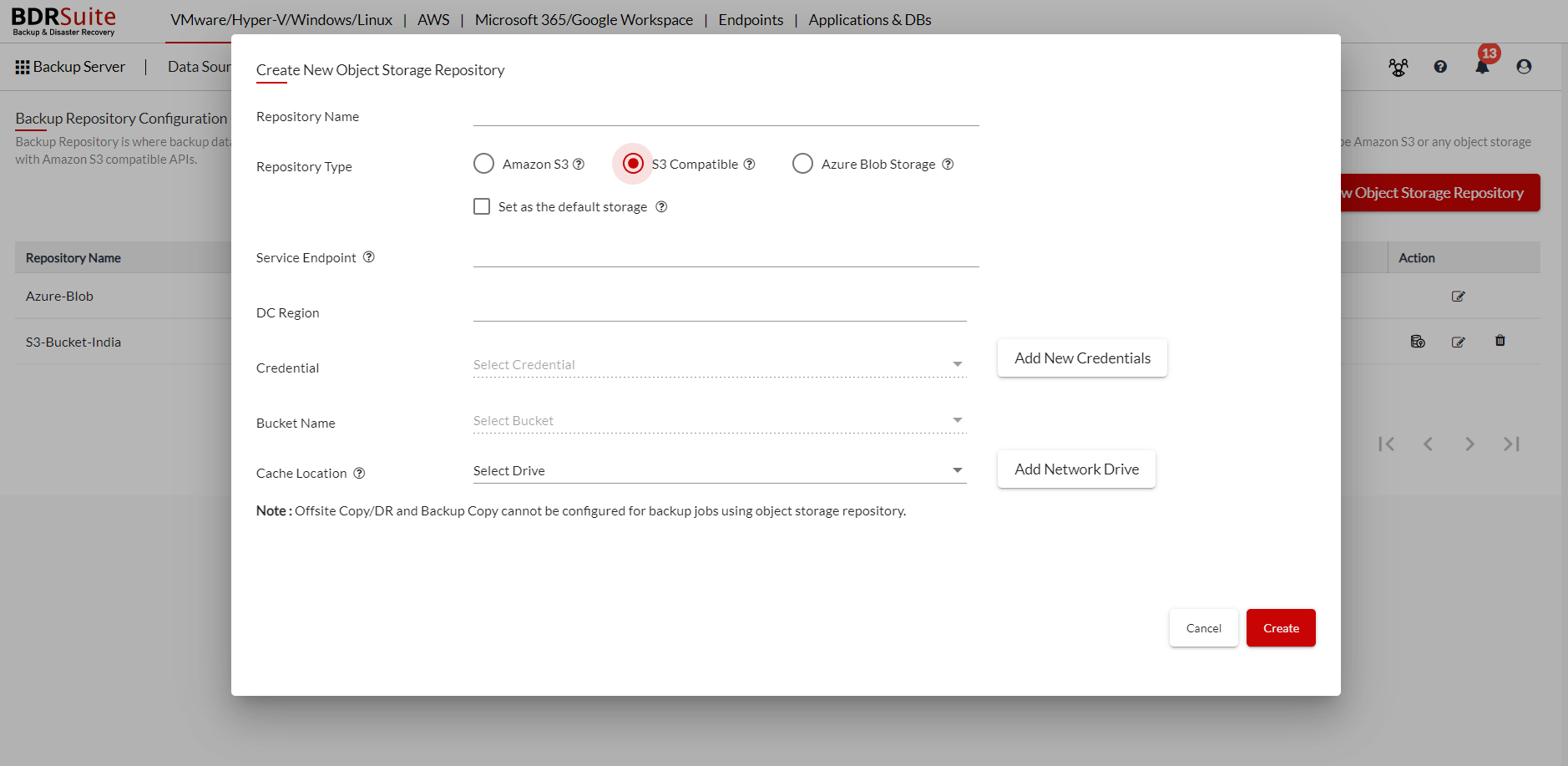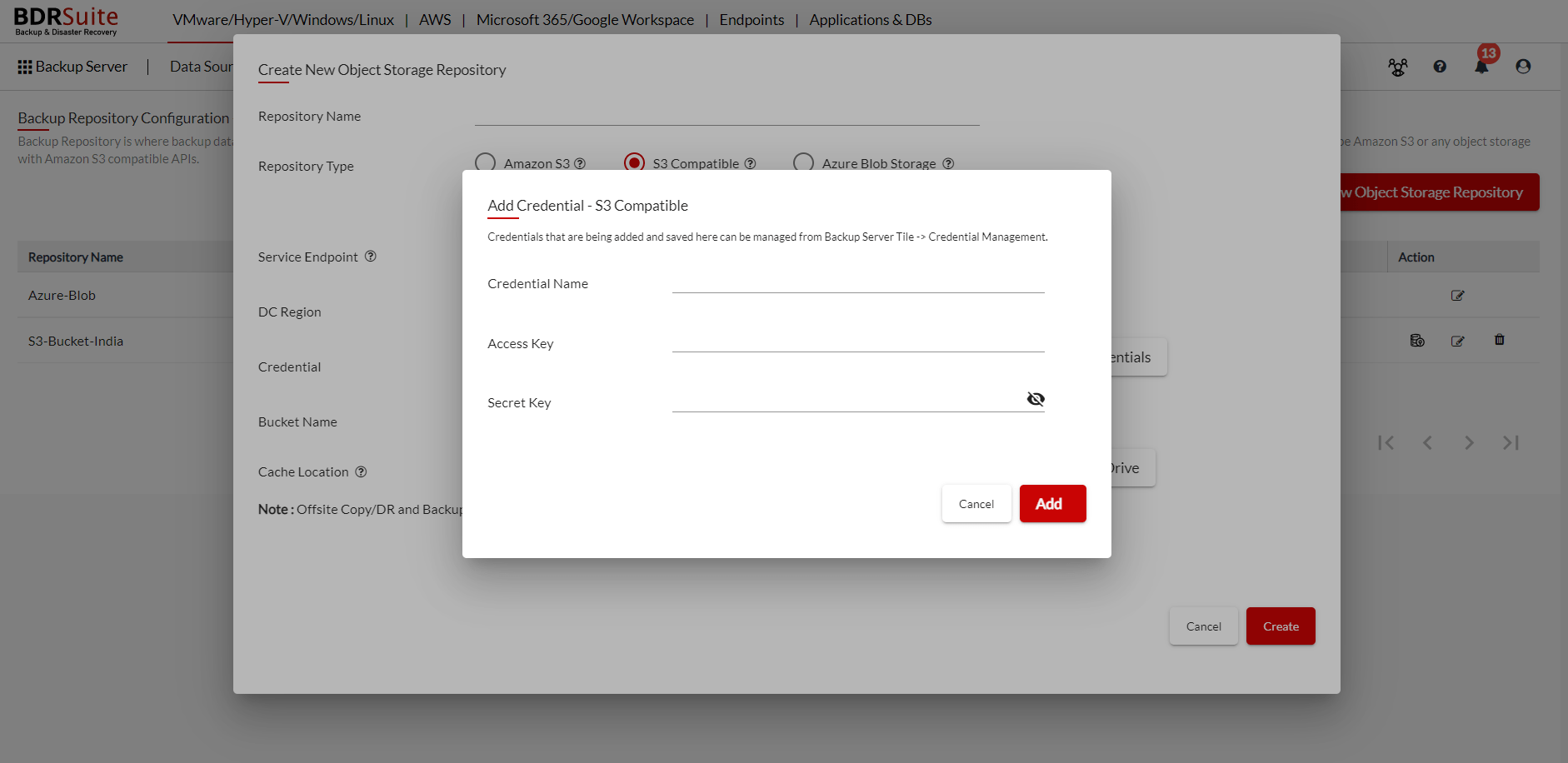About BDRSuite:
BDRSuite is a Comprehensive and Cost-Effective Backup & Disaster Recovery Solution designed to protect data that span across Data Centers/Private Cloud (VMware, Hyper-V, Windows, Linux, Applications & Databases), Public Cloud (AWS), SaaS (Microsoft 365, Google Workspace), and Endpoints (Windows, Mac).
Backup Storage Repository Supported in BDRSuite:
BDRSuite supports a wide range of scalable storage targets as backup repositories:
- Block Storages – Direct, NAS, SAN
- Object Storages – AWS S3, Azure Blob, & S3 Compatible storage like Wasabi, Backblaze, etc
We already discussed how to configure object-based cloud storage such as Azure Blob and Wasabi as backup storage repositories in earlier blogs.
How to Store Backup Data on Azure Blob using BDRSuite
How to Store Backup Data on Wasabi Cloud using BDRSuite
Adding to the stack, here we are with another S3-compatible storage – Backblaze.
Backblaze Cloud Storage:
Backblaze is a cloud storage solution built using Amazon S3 APIs, trusted by many businesses. It is simple and reliable. Many small and medium businesses consider Backblaze for its pocket-friendly pricing structure.
In this blog, we will discuss how to configure Backblaze Cloud Storage as a Backup Repository in BDRSuite to store the backup data.
Prerequisites:
- Download and Install BDRSuite Backup Server. Click here for installation instructions
- Make sure you have the Backblaze account credential – Access Key and Secret Key
Process:
- Add Backblaze cloud storage to the BDRSuite Backup Server
- The added Backblaze cloud storage can then be configured as a backup storage repository for primary backup, backup copy, (or) offsite copy
- Once the backup/backup copy is scheduled, a secure connection will be established to transfer the backup data to the Backblaze repository
Note: Backblaze Cloud Repository can be set as default storage to store the backup data of all jobs configured in the BDRSuite Server (or) you can select the repository for specific jobs during backup configuration
Configuring Backblaze Cloud as Backup Repository in BDRSuite
Step 1: Log in to the BDRSuite Backup Server console. Navigate to the Backup Server Tile -> Object Storage and click on the ‘Create New Object Storage Repository’ button.
Step 2: Enter the following details:
- In the Repository Name field, specify a name for the new object storage repository
- For the Repository Type, choose S3 Compatible
- Enter the Service Endpoint (s3.us-west-004.backblazeb2.com), which will enable connectivity to the Backblaze Cloud Storage account from the BDRSuite Backup Server
- Specify the Data Center (DC) Region
Note: Backblaze’s B2 Cloud Storage is used here. In your Backblaze Account, navigate to Buckets under the B2 Cloud Storage tab on the left side which will show your Service Endpoint and DC region details.

Step 3: From the Credentials drop-down list, select user credentials to access your Backblaze storage account if you already have added the credentials. Otherwise, click the Add New Credential button which opens a dialog box.
- Specify a credential name to identify your credential record, and provide the Secret Key and Access Key of your Backblaze Cloud Storage Account
- You can manage all the S3 Compatible Storage account Credentials from Backup Server Tile -> Credential Management -> S3 Compatible
Note: In your Backblaze account, navigate to App Keys under the Account tab and click on Add a new Application Key to find the KeyID which will be the Access Key, and the applicationKey which will be your secret key both of which will be S3 compatible.

Step 4: From the Bucket Name drop-down list, select a bucket. Make sure that the bucket where you want to store your backup data is created in advance.
Note: In your Backblaze account, navigate to Buckets under the B2 Cloud Storage tab and click on Create a Bucket to create a new bucket.
Step 5: Choose a cache location to store backup data temporarily before uploading it to the Backblaze Cloud Storage. Local drives and Network drives added to the BDRSuite Backup Server will be shown in the dropdown list which can be selected as Cache Location.
Step 6: Once all the fields are configured, click the ‘Create’ button and the Backblaze cloud will be added as a Backup Repository.
Configuring Backup to Backblaze with BDRSuite
You can configure image-level or file-level backups for Workloads – VMware VMs, Hyper-V VMs, Windows Servers, Linux Servers, Endpoints (Windows & Mac), & SaaS Applications – Microsoft 365, & Google Workspace and store their backup data in the Backblaze Cloud Storage.
Check out our latest user guide to learn more about backup configurations, restores, and management of the different components mentioned, using the BDRSuite.
Be sure to download and explore BDRSuite in your environment with our fully-functional 30-day free trial version

